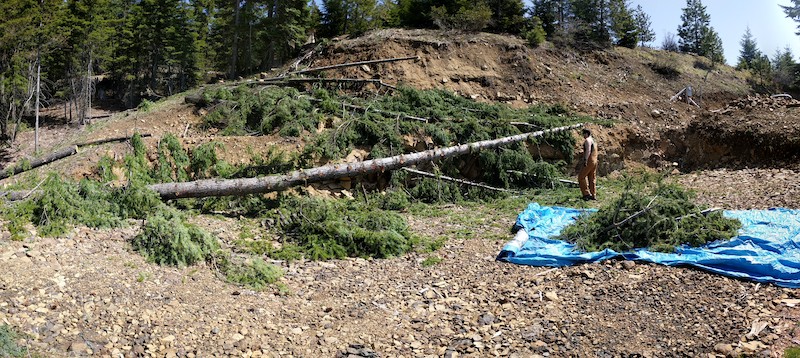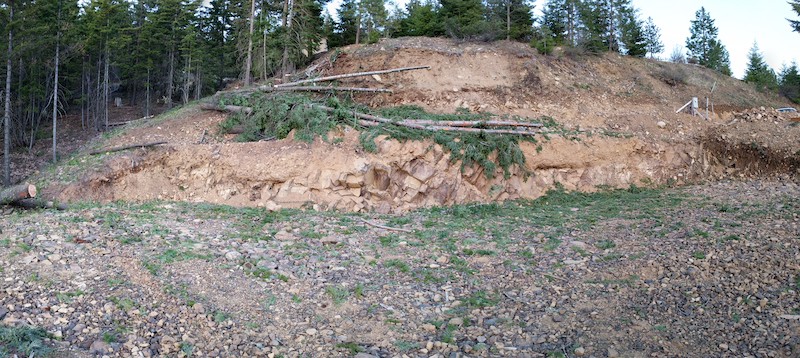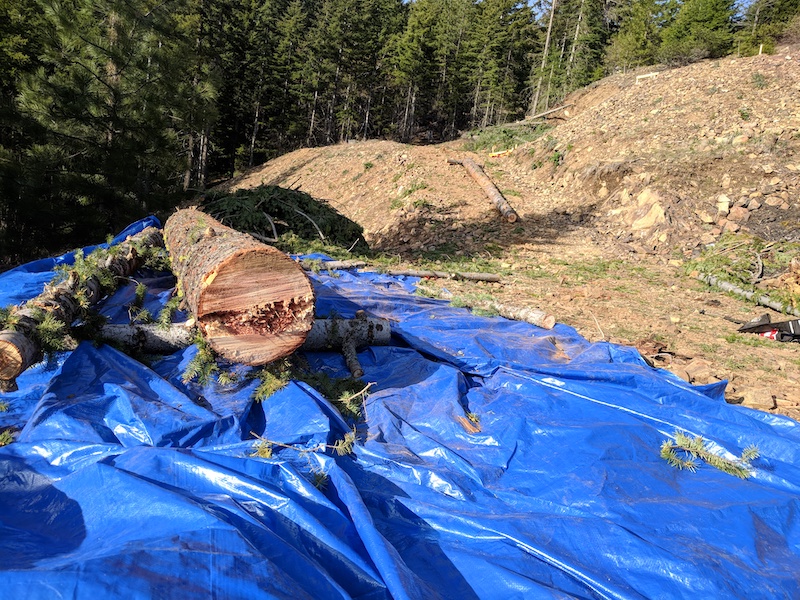Removing Some Trees
Thu, Apr 26, 2018This has been the most physically demanding few days I’ve had in a very long time. We had eight pine trees cut down. We briefly considered cutting these down ourselves, but tree cutting is dangerous, and we thought best left up to the professionals.
We paid a local company $500 to take them down, and de-limb them. We got a great deal since he was just starting his business and was looking for someone to leave a good review (we did, and he did great work).
These eight trees were close to where we want to put the cabin, and we figured it be better to cut them down now (let them fall where they may) as opposed to having to cut them down later. We also wanted to have a few logs from the property to incorporate into the cabin build somehow. I am not sure how yet, but we will find a spot to put them. Maybe some beam or truss work.
 Eight fallen trees. A few of them are just out of view.
Eight fallen trees. A few of them are just out of view.
My brother and I showed up Thursday to start the clean up. Eight trees generates a lot of debris. We are in a fire hazard zone (in fact, there was a large forest fire that came within a few hundred yards of our lot just the summer prior) and so it was important to get all of it either burned (now in the wet spring) or removed from the lot.
Cleaning up the Limbs
We have a large fire pit on the lot. It’s pretty cool, actually. There is a natural cut in the rock face that provides roughly 180 degrees of wind protection. The plan was to move all the debris down to this fire pit, and burn throughout the weekend. The problem was, the debris was mostly up on our build pad, roughly 80 yards away and up an hill.
For the first run of debris, we loaded up two wheelbarrows with branches and pushed them down the hill. The road here is filled with large rocks and ruts and makes for a bouncy ride. Half our load was tossed out by the time we got down. This isn’t going to work with wheelbarrows.
Our next idea was to use an old tarp we found on the lot, load a bunch of sticks on it, wrap it like a burrito, and drag it down the hill. This worked great the first time, but the tarp was pretty torn up. We got one more haul out of it before we had to abandon that idea.

I have a bag of ratchet straps in my truck. These are normally for securing cargo. We got the idea that maybe we could lay three of these down in parallel and stack the branches perpendicular on top of them. We’d get a big pile going, then close the straps around the pile. We’d have a bundle of sticks, and we’d pull it down the hill. We weren’t sure how well the bundle would stay together as it was pulled down the hill. We also weren’t sure how we were going to physically pull such a large bundle down the hill. I know we did so with the tarp, but the tarp provided some level of finesse over the rocks and dirt. Now we have branches jutting into the ground at every step.
For getting this bundle down the hill, my brother had an excellent idea. His Jeep has a winch and the line is just long enough to reach our bundles if he parks the jeep near the fire pit.
There is something satisfying about watching a giant log or pile of sticks being slowly drug across the ground.
Now we had a method of transport, so it was time to get to work. One of us would cut limbs into more manageable sizes, and toss to a loose pile. The other would stack the branches on the straps in a neater pile. Winch and repeat.

Storing the Logs
It was starting to get late and we wanted to get a couple of the logs out of the way so that we could start in on the bigger pile the next day. We also wanted to test how feasible it was going to be to cut a 20’ section of log and winch it down the hill to where we were going to stack these up and let them dry for a couple years.
We cut a few logs off and got the winch tied around one. To tie the log, you just wrap the winch cable around the log, and latch the winch hook to its own line (making a loop that the log sits in). The tension of the winch will secure that loop to the log. We kept the loop a few feet from the end of the log so that the log was being pulled end to end, rather than from the middle and potentially rolling down the hill.
We started with the biggest, because why not. My brother had picked up a ‘recovery damper’ for his winch (we figured we’d probably resort to using it to pull the logs down the hill). This accessory helps drag the line down if it snaps. You don’t want to be in the crossfire of a winch cable under tension when it snaps. Fortunately for us, we didn’t have any issues!

With the first log down, we finished the evening pulling a few more down.
We’re stacking them on a large tarp and cross beams. The logs will be wrapped in the tarp like a burrito, and the cross beams will provide air movement to the logs on all sides. I picked up a can of Anchor Seal to seal the ends of the logs too. When you’re drying out large pieces of wood, the ends (and outside faces) will dry more quickly than the interior, which leads to cracking. Anchor Seal is painted on the ends to help seal in the moisture, and hopefully match the evaporation rate with the rest of the log.
We removed the bark on the logs. I had read mixed opinions on doing this. Some said it helped slow the release of moisture (again, helpful to prevent cracking), and some said leaving it on would increase mold growth. Since these logs were going to be left outside in a remote area (that I wouldn’t be able to check on frequently), we decided to strip the bark now. If we had some cracking, that was not the end of the world since the logs would be used cosmetic features of the cabin (we briefly entertained using them for structural components, but found out how much work that would be to have the wood graded and approved for such purposes). So a few cracks weren’t the end of the world.
Having a climate controlled room to dry these logs out would be ideal, but this is the best we can do right now. Hopefully the tarp keeps out enough rain and snow that the moisture level of these logs drops enough that we can use them in the cabin. We may need to dry them out for a few more months in the garage once that is built.
Our friend, Coop, came up early on Friday to help us finish the job. He did most of the bark stripping (this started off fun and sorta easy, but as the blades dulled, it became slow and difficult. Pro tip: bring a sharpener). Coop was a huge help and we had all the limbs cleaned up early on Friday.
The rest of the day was spent cutting and stacking logs. After we had about six good sized logs, we decided to just start cutting the rest into firewood. We weren’t that confident the logs would be even be usable and maneuvering them was a lot of work. Six logs would let us do some cool things.
Our dad showed up that afternoon and it was a good thing because we were having a hard time getting the chain saws started again after the lunch break. He gave them a quick field tune-up and got them running again. He also brought some fresh energy and operated the chain saws for the rest of the day! The rest of the wood was cut into rounds for firewood.

Two logs proved to be too big and were left to be later pushed off the hill and into our ravine by our excavator. We left another higher up on the hill, behind the build site. We’re tired and we got to thinking it was a good spot for a bench.

Saturday was the semi-annual HOA meeting and we got to introduce ourselves and meet a few of the neighbors. The HOA seems pretty level-headed and is primarily focused on being Firewise, a national program to reduce the risk of wildfires and impact to your home/community, and ensuring our shared roads are in good, safe condition. The HOA will rent a wood chipper this summer to chip any branches we have on our lot (we already burned all ours!), and there will be some minor repairs to the roads.
It’s been a long weekend, and my activity-tracking watch says I burned off enough calories to enjoy few guilt-free beers, so time to get to it.
Next Post > > < < Previous Post